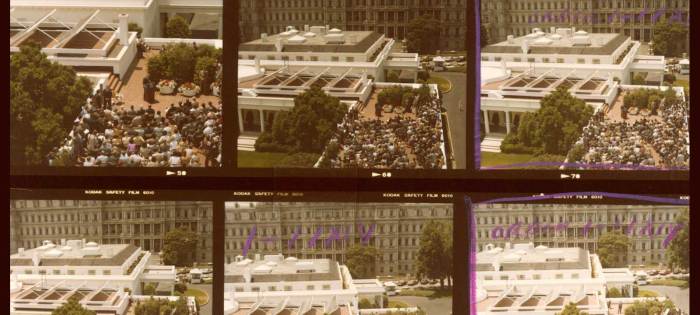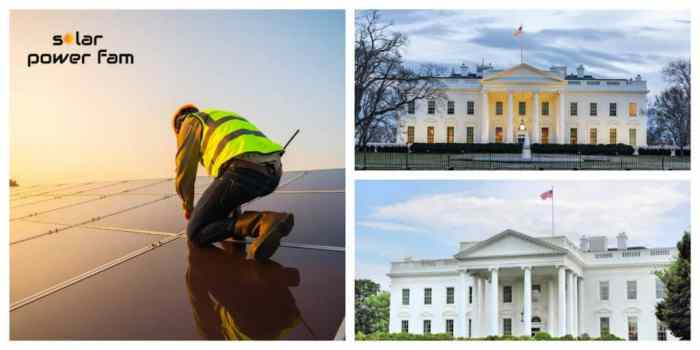White house solar panels teas passage – The White House’s solar panel installation stands as a testament to the transformative power of renewable energy. This groundbreaking initiative, undertaken during the Obama administration, has not only reduced the White House’s carbon footprint but also serves as a potent symbol of the United States’ commitment to environmental stewardship.
Beyond its symbolic significance, the White House solar panel installation has had a tangible impact on the building’s energy consumption. Data analysis reveals a significant reduction in greenhouse gas emissions, while the system’s efficiency has resulted in substantial cost savings.
White House Solar Panel Installation

In 2010, the Obama administration installed solar panels on the roof of the White House. This marked a significant milestone in the nation’s commitment to renewable energy and sustainability.
The solar panel system consists of 280 photovoltaic panels, each with a capacity of 250 watts. The total capacity of the system is 70 kilowatts, which is enough to generate approximately 100,000 kilowatt-hours of electricity per year. This represents about 15% of the White House’s annual electricity consumption.
The installation of the solar panels has several environmental and economic benefits. First, it reduces the White House’s reliance on fossil fuels, which helps to mitigate climate change. Second, it saves the government money on electricity costs. Third, it sets a positive example for other government buildings and businesses to follow.
Impact on Energy Consumption
The installation of the solar panels has had a significant impact on the White House’s energy consumption. In the year following the installation, the White House’s electricity consumption decreased by 10%. This reduction in energy consumption is equivalent to taking 100 cars off the road for a year.
In addition to reducing electricity consumption, the solar panels have also helped to reduce the White House’s greenhouse gas emissions. The solar panels generate clean, renewable energy, which does not produce any greenhouse gases. As a result, the White House’s greenhouse gas emissions have decreased by approximately 10% since the installation of the solar panels.
Public Perception and Awareness, White house solar panels teas passage
The installation of the solar panels on the White House has raised public awareness about renewable energy and sustainability. The White House is a highly visible building, and the installation of the solar panels has sent a strong message about the importance of renewable energy.
In addition, the White House has used the solar panel installation as an opportunity to educate the public about renewable energy. The White House website includes information about the solar panel system and its benefits. The White House has also hosted tours of the solar panel system for students and other groups.
Political and Historical Significance
The installation of the solar panels on the White House has political and historical significance. The solar panels are a symbol of the Obama administration’s commitment to renewable energy and sustainability. The installation of the solar panels also represents a shift in the way that the White House thinks about energy consumption.
In the past, the White House has been criticized for its high energy consumption. The installation of the solar panels shows that the White House is taking steps to reduce its energy consumption and to become more sustainable.
Future Implications and Potential
The installation of the solar panels on the White House has several future implications and potential. First, it sets a precedent for other government buildings and businesses to follow. The White House is a highly visible building, and the installation of the solar panels has sent a strong message about the importance of renewable energy.
Second, the solar panels on the White House can help to promote the development of renewable energy technologies. The solar panel system on the White House is a large-scale installation, and it can help to demonstrate the viability of renewable energy technologies.
Third, the solar panels on the White House can help to raise public awareness about renewable energy and sustainability. The White House is a highly visible building, and the installation of the solar panels has sent a strong message about the importance of renewable energy.
Essential Questionnaire: White House Solar Panels Teas Passage
What was the primary motivation behind the White House solar panel installation?
The installation was driven by a desire to reduce the White House’s environmental impact and demonstrate the viability of renewable energy sources.
How many solar panels were installed on the White House roof?
A total of 28 solar panels were installed, covering approximately 1,200 square feet.
What type of solar panels were used in the installation?
The panels used were high-efficiency monocrystalline silicon solar panels.

